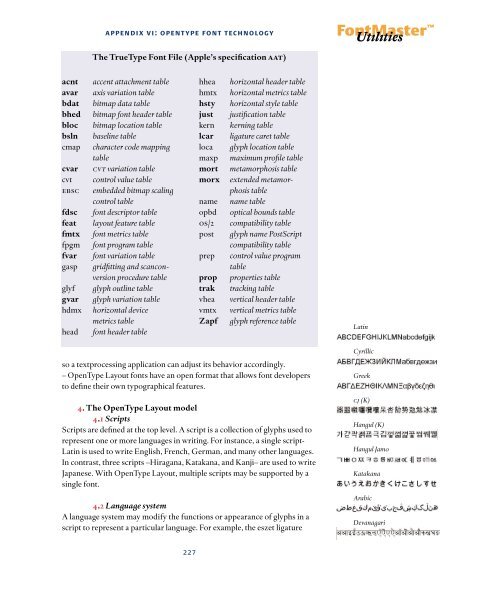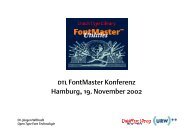DTL FontMaster Manual1.1 PDF
DTL FontMaster Manual1.1 PDF
DTL FontMaster Manual1.1 PDF
Create successful ePaper yourself
Turn your PDF publications into a flip-book with our unique Google optimized e-Paper software.
appendix vi: opentype font technology<br />
The TrueType Font File (Apple’s specification aat)<br />
acnt accent attachment table<br />
avar axis variation table<br />
bdat bitmap data table<br />
bhed bitmap font header table<br />
bloc bitmap location table<br />
bsln baseline table<br />
cmap character code mapping<br />
table<br />
cvar cvt variation table<br />
cvt control value table<br />
ebsc embedded bitmap scaling<br />
control table<br />
fdsc font descriptor table<br />
feat layout feature table<br />
fmtx font metrics table<br />
fpgm font program table<br />
fvar font variation table<br />
gasp gridfitting and scanconversion<br />
procedure table<br />
glyf glyph outline table<br />
gvar glyph variation table<br />
hdmx horizontal device<br />
metrics table<br />
head font header table<br />
hhea horizontal header table<br />
hmtx horizontal metrics table<br />
hsty horizontal style table<br />
just justification table<br />
kern kerning table<br />
lcar ligature caret table<br />
loca glyph location table<br />
maxp maximum profile table<br />
mort metamorphosis table<br />
morx extended metamorphosis<br />
table<br />
name name table<br />
opbd optical bounds table<br />
os/2 compatibility table<br />
post glyph name PostScript<br />
compatibility table<br />
prep control value program<br />
table<br />
prop properties table<br />
trak tracking table<br />
vhea vertical header table<br />
vmtx vertical metrics table<br />
Zapf glyph reference table<br />
so a textprocessing application can adjust its behavior accordingly.<br />
– OpenType Layout fonts have an open format that allows font developers<br />
to define their own typographical features.<br />
4. The OpenType Layout model<br />
4.1 Scripts<br />
Scripts are defined at the top level. A script is a collection of glyphs used to<br />
represent one or more languages in writing. For instance, a single script-<br />
Latin is used to write English, French, German, and many other languages.<br />
In contrast, three scripts –Hiragana, Katakana, and Kanji– are used to write<br />
Japanese. With OpenType Layout, multiple scripts may be supported by a<br />
single font.<br />
4.2 Language system<br />
A language system may modify the functions or appearance of glyphs in a<br />
script to represent a particular language. For example, the eszet ligature<br />
227<br />
Latin<br />
Cyrillic<br />
Greek<br />
cj (K)<br />
Hangul (K)<br />
Hangul Jamo<br />
Katakana<br />
Arabic<br />
Devanagari



